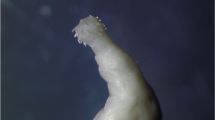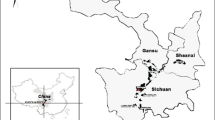Abstract
The giant thorny-headed worm Macracanthorhynchus hirudinaceus is a zoonotic acanthocephalan species with a worldwide distribution. Its natural definitive hosts are primarily pigs and wild boars (Sus scrofa), and scarabaeid beetles serve as the intermediate host. To date, there has only been one record of this acanthocephalan in Japan: a Ryukyu wild boar (Sus scrofa riukiuanus) hunted in 1973 on Amami Island, faraway from the Japanese mainland. The present study reports the second case of this acanthocephalan in Japan: a Japanese wild boar (Sus scrofa leucomystax) hunted in May 2017 in Yamaguchi Prefecture, the westernmost part of the Japanese mainland (Honshu). More than a dozen acanthocephalans (123 to 233 mm in length and 5 to 6 mm in width) were found with their proboscides inserted deeply into the intestinal wall, forming grossly visible nodules on the external surface. Isolated worms underwent a molecular genetic characterization of the ribosomal RNA gene (rDNA) and mitochondrial cytochrome c oxidase subunit 1 gene (cox-1). Long rDNA nucleotide sequences (5870 to 5890 bp) spanning the beginning of the 18S rDNA through to the 28S rDNA, including the internal transcribed spacer regions, and 1384-bp cox-1 nucleotide sequences were obtained. In the future, in conjunction with the accumulation of molecular genetic data of multiple M. hirudinaceus isolates from different endemic localities abroad, our data may help to postulate the origin or present transmission status of this extremely rarely encountered acanthocephalan in Japan.




Similar content being viewed by others
References
Berenji F, Fata A, Hosseininejad Z (2007) A case of Moniliformis moniliformis (Acanthocephala) infection in Iran. Korean J Parasitol 45:145–148
de-la-Muela N, Hernández-de-Luján S, Ferre I (2001) Helminths of wild boar in Spain. J Wildl Dis 37:840–843
Dingley D, Beaver PC (1985) Macracanthorhynchus ingens from a child in Texas. Am J Trop Med Hyg 34:918–920
Dorris M, Viney ME, Blaxter ML (2002) Molecular phylogenetic analysis of the genus Strongyloides and related nematodes. Int J Parasitol 32:1507–1517
Furuno K, Lee K, Itoh Y, Suzuki K, Yonemitsu K, Kuwata R, Shimoda H, Watarai M, Maeda K, Takano A (2017) Epidemiological study of relapsing fever borreliae detected in Haemaphysalis ticks and wild animals in the western part of Japan. PLoS One 12:e0174727
Garcia LS (2007) Diagnostic medical parasitology, 5th edn. ASM Press, Washington DC, p 1202
García-Varela M, Nadler SA (2005) Phylogenetic relationships of Palaeacanthocephala (Acanthocephala) inferred from SSU and LSU rDNA gene sequences. J Parasitol 91:1401–1409
Golvan YJ (1994) Nomenclature of the Acanthocephala. Res Rev Parasitol 54:135–205
Hara Y, Terada Y, Yonemitsu K, Shimoda H, Noguchi K, Suzuki K, Maeda K (2014) High prevalence of hepatitis E virus in wild boar (Sus scrofa) in Yamaguchi prefecture, Japan. J Wildl Dis 50:378–383
Hemsrichart V, Pichyangkura C, Chitchang S, Vutichamnong U (1983) Eosinophilic enteritis due to Macracanthorhynchus hirudinaceus infection: report of 3 cases. J Med Assoc Thailand 66:303–310
Iseki M, Kimata I, Izumo A, Takada S, Aono S (1985) The first case of infection with Moniliformis dubius Meyer, 1932 (Acanthocephala) in Japan, and notes on the classification of related species of the parasite. Jpn J Parasitol 34:219–228 (in Japanese with English summary)
Kamiya M, Suzuki H, Hayashi Y (1977) Macracanthorhynchus hirudinaceus (Pallas, 1781) from a wild boar, Sus scrofa riukiuanus on Amami Island, southern Japan. Jpn J Parasitol 26:260–264 (in Japanese with English summary)
Kates KC (1942) Viability of eggs of the swine thorn-headed worm (Macracanthorhynchus hirudinaceus). J Agric Res 64:93–100
Kates KC (1943) Development of the swine thorn-headed worm, Macracanthorhynchus hirudinaceus, in its intermediate host. Am J Vet Res 4:173–181
Kliks M, Tantachamrun T, Chaiyaporn V (1974) Human infection by an acanthocephalan Macracanthorhynchus hirudinaceus in Tailand: new light on a previous case. Southeast Asian J Trop Med Public Health 5:303–309
Leng YJ, Huang WD, Liang PN (1983) Human infection with Macracanthorhynchus hirudinaceus Travassos, 1916 in Guangdong Province, with notes on its prevalence in China. Ann Trop Med Parasitol 77:107–109
Lounibos LP (2002) Invasion by insect vectors of human disease. Annu Rev Entomol 47:233–266
Makouloutou P, Setsuda A, Yokoyama M, Tsuji T, Saita E, Torii H, Kaneshiro Y, Sasaki M, Maeda K, Une Y, Hasegawa H, Sato H (2013) Genetic variation of Gongylonema pulchrum from wild animals and cattle in Japan based on ribosomal RNA and mitochondrial cytochrome c oxidase subunit I genes. J Helminthol 87:326–335
Mathison BA, Bishop HS, Sanborn CR, Souza SS, Bradury R (2016) Macracanthorhynchus ingens infection in an 18-month-old child in Florida: a case report and review of acanthocephaliasis in human. Clin Inf Dis 63:1357–1359
Mowlavi GR, Massoud J, Mobedi I, Solaymani-Mohammadi S, Gharagozlou MJ, Mas-Coma S (2006) Very highly prevalent Macracanthorhynchus hirudinaceus infection of wild boar Sus scrofa in Khuzestan province, south-western Iran. Helminthologia 43:86–91
Nadler SA, Carreno RA, Mejia-Madrid H, Ullberg J, Pagan C, Houston R, Hugot JP (2007) Molecular phylogeny of clade III nematodes reveals multiple origins of tissue parasitism. Parasitology 134:1421–1442
Near TJ, Garey JR, Nadler SA (1998) Phylogenetic relationships of the acanthocephalan inferred from 18S ribosomal DNA sequences. Mol Phylogenet Evol 10:287–298
Pavlović IN, Kulišić ZB, Tambur Z, Protić NM (2010) Scarabidae—intermediate host for Macracanthorhynchus hirudinaceus. Proc Nat Sci Matica Srpska Novi Sad (119):89–95
Pradatsundarasar A, Pechranond K (1965) Human infection with the acanthocephalan Macracanthorhynchus hirudinaceus in Bangkok: report of a case. Am J Trop Med Hyg 14:774–776
Radomyos P, Chobchuanchom A, Tungtrongchitr A (1989) Intestinal perforation due to Macracanthorhynchus hirudinaceus infection in Thailand. Trop Med Parasitol 40:476–477
Richardson DJ (2005) Identification of cystacanths and adults of Oligacanthorhynchus tortuosa, Macracanthorhynchus ingens, and Macracanthorhynchus hirudinaceus based on proboscis and hook mophometrics. J Arkansas Acad Sci 59:205–209
Sato H, Suzuki K, Osanai A, Kamiya H, Furuoka H (2006) Identification and characterization of the threadworm, Strongyloides procyonis, from feral raccoons (Procyon lotor) in Japan. J Parasitol 92:63–68
Setsuda A, Da N, Hasegawa H, Behnke JM, Rana HB, Dhakal IP, Sato H (2016) Intraspecific and interspecific genetic variation of Gongylonema pulchrum and two rodent Gongylonema spp. (G. aegypti and G. neoplasticum), with the proposal of G. nepalensis n. sp. for the isolate in water buffaloes from Nepal. Parasitol Res 115:787–795
Solaymani-Mohammadi S, Mobedi I, Rezaian M, Massoud J, Mohebali M, Hooshyar H, Ashrafi K, Rokni MB (2003) Helminth parasites of the wild boar, Sus scrofa, in Luristan province, western Iran and their public health significance. J Helminthol 77:263–267
Tesana S, Mitrchai J, Chunsuttwat S (1982) Acute abdominal pain due to Macracanthorhynchus hirudinaceus infection: a case report. Southeast Asian J Trop Med Public Health 12:262–264
Thompson JD, Higgins DG, Gibson TJ (1994) CLUSTAL W: improving the sensitivity of progressive multiple sequence alignment through sequence weighting, positions-specific gap penalties and weight matrix choice. Nucleic Acids Res 22:4673–4680
Tran BT, Sato H, Luc PV (2015) A new Cosmocercoides species (Nematoda: Cosmocercidae), C. tonkinensis n. sp., in the scale-bellied tree lizard (Acanthosaura lepidogaster) from Vietnam. Acta Parasitol 60:407–416
Tran BT, Ong AV, Luc PV, Sato H (2016) Morphological and molecular genetic diversity of Strongyluris calotis (Nematoda: Ascaridida: Heterakidae) in south east and east Asian lizards. Parasitol Res 115:2807–2816
Untergasser A, Cutcutache I, Koressaar T, Ye J, Faircloth BC, Remm M, Rozen SG (2012) Primer3—new capabilities and interfaces. Nucleic Acids Res 40:e115
Van de Peer DRYP, Wuyts J, Winkelmans T, De Wachter R (2000) The European small subunit ribosomal RNA database. Nucleic Acids Res 28:175–176
Varcasia A, Scala A, Zidda A, Cabras PA, Gaglio G, Tamponi C, Pipia AP, Setsuda A, Sato H (2017) First record of Gongylonema nepalensis in deomistic and wild ruminants in Europe. Vet Parasitol 246:11–18
Vora N (2008) Impact of anthropogenic environmental alterations on vector-borne diseases. Medscape J Med 10:238
Weber M, Wey-Fabrizius AR, Podsiadlowski L, Witek A, Schill RO, Sugár L, Herlyn H, Hankeln T (2013) Phylogenetic analyses of endoparasitic Acanthocephala based on mitochondrial geneomes suggest secondary loss of sensory organs. Mol Phylogenet Evol 66:182–189
Xu L-Q, Yu S-H, Xu S-H (2000) Distribution and pathogenic impact of human parasites in China. People’s Medical Publishing House, Beijing, p 928
Yonemitsu K, Terada Y, Kuwata R, Nguyen D, Shiranaga N, Tono S, Matsukane T, Yokoyama M, Suzuki K, Shimoda H, Takano A, Muto M, Maeda K (2016) Simple and specific method for detection of antibodies against hepatitis E virus in mammalian species. J Virol Methods 238:56–61
Zhong HL, Feng LB, Wang CX (1983) Human infection with Macracanthorhynchus hirudinaceus causing serious complications in China. Chin Med J 96:661–668
Acknowledgments
We would like to express our sincere thanks to the local hunters and municipal officers engaged in the protection of wildlife in Shimonoseki City, Yamaguchi Prefecture, Japan, who made this study possible. We are indebted to Professor Emeritus Shuhei Tanaka, Faculty of Agriculture, Yamaguchi University, for his help with the SEM.
Author information
Authors and Affiliations
Corresponding author
Additional information
Section Editor: Christoph G. Grevelding
Rights and permissions
About this article
Cite this article
Kamimura, K., Yonemitsu, K., Maeda, K. et al. An unexpected case of a Japanese wild boar (Sus scrofa leucomystax) infected with the giant thorny-headed worm (Macracanthorhynchus hirudinaceus) on the mainland of Japan (Honshu). Parasitol Res 117, 2315–2322 (2018). https://doi.org/10.1007/s00436-018-5922-7
Received:
Accepted:
Published:
Issue Date:
DOI: https://doi.org/10.1007/s00436-018-5922-7




